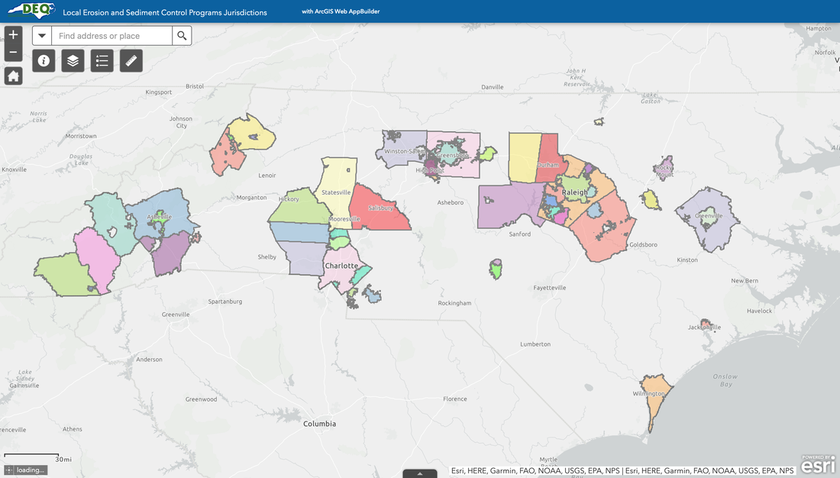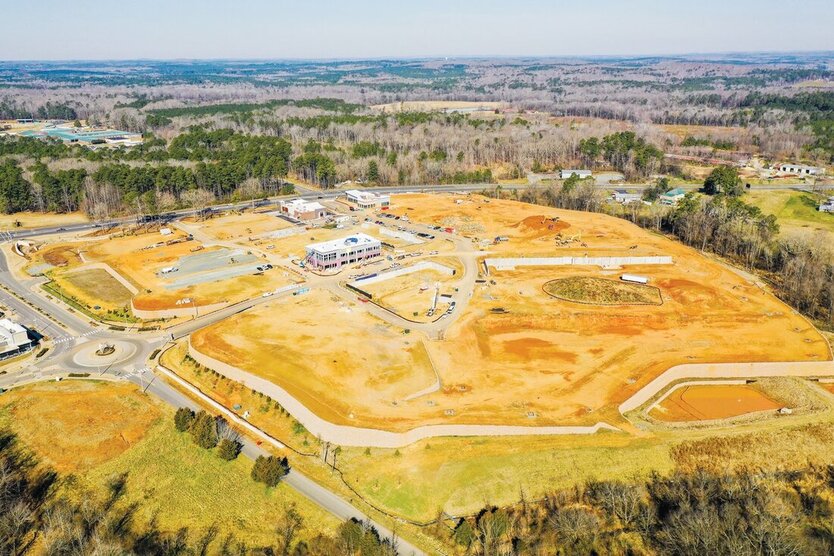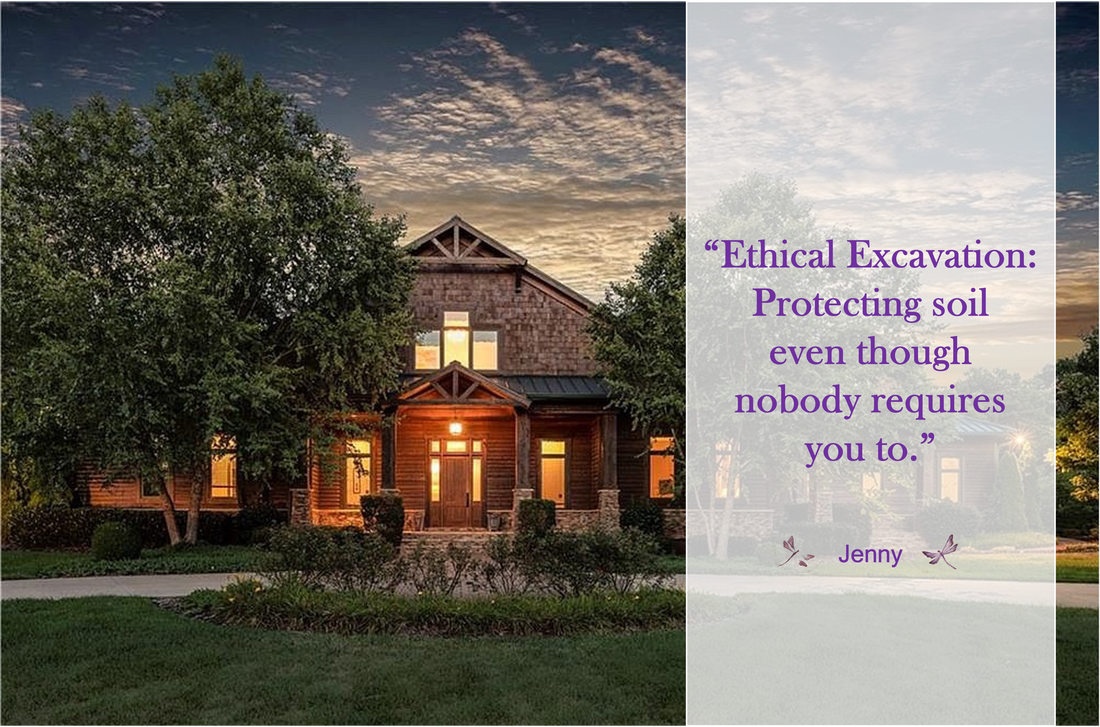
 There’s a reason why it’s not common practice to preserve soils on a construction site. State and federal regulations put the burden of responsibility on the homeowner. They make it YOUR responsibility to educate yourself about methods of soil preservation, find solutions, and come up with a plan. Most homeowners don’t have the time or resources to do this and so they rely on their builder to deal with all site development issues, though builders also are not encouraged to find and implement soil-saving techniques. To make matters worse, if you don’t take on this responsibility, then you end up paying the extra cost for soil remediation. And if you and your builder don’t abide by the rules and regulations set forth by erosion control agencies, then you pay heavy fines and stop-work orders. You may not be supported by current regulatory agencies or by typical site development practices, however you ARE supported by Pippin. In this ninth post of the Regenerative Design series, I explain what the current rules and regulations are in NC for clearing land and I offer suggestions for taking responsibility for saving soil and money. The Current Myopic View of Soil Current government rules and regulations regarding soil conservation tend to only be in context to watershed preservation, NOT soil preservation. This is horribly misleading! The North Carolina Sedimentation Pollution Control Act (SPCA) of 1973 was enacted to prevent pollution of waterways by sedimentation while still allowing development. This myopic view only sees soil as a pollutant and therefore soil is treated as such on nearly every construction site across the state. Do not be fooled! Just because you and your builder follow the rules mandated by the SPCA it does NOT mean you’re successfully preserving or protecting soils. There are currently ZERO federal regulations for preserving and protecting soils on a construction site. Which means it’s up to YOU to demand that your soils be saved by implementing a regenerative site plan BEFORE breaking ground. That being said, the SPCA was created for good reason and it’s equally important to preserve waterways. I propose you do both; preserve waterways AND soils! Planning for Erosion The portion of your property that must be completely cleared of topsoil and vegetation will remain as bare exposed soil until the project is complete and the necessary landscape remediation has taken place. The cost for remediation will come out of your pocket so it would be wise to disturb as little area as possible. (Check out our next blog that discusses techniques for saving soil and money on a construction site). The exposed soil is highly susceptible to erosion. Displaced soils in bodies of water cause a chain reaction that degrades the health of fish and other aquatic species. Because of this impact on waterways, most states have regulations requiring an Erosion & Sedimentation Control (E&SC) plan as part of the excavation and building process. Note to Lake Norman Residents: If you want to enjoy the lake your home was designed to maximize enjoyment of, it’s imperative that you go above and beyond the minimum requirements of an Erosion & Sedimentation Control plan. An effective Erosion & Sedimentation Control Plan (E&SC) needs to be tailor-made for your specific property taking into consideration the specific soils, slope, watershed, vegetation, and adjacent property details. An E&SC plan can be written by you, your builder, a landscape designer, your uncle, or your dog. Some plans will be more effective than others. This means YOU have control over what goes into your site plan. YOU have the power to choose regeneratively. Click HERE to see a sample Erosion & Sediment Control plan. This E&SC plan will become part of your overall site plan. The more techniques used to preserve soil, the less you will have to spend to remediate and ship in new soil to replace the removed or destroyed soil. Our next blog will elaborate on soil and money saving techniques that can easily be included in a regenerative site plan. What’s Mandatory in Your Area? Erosion and sedimentation control in NC is required regardless of the size of the disturbed land. Land with a disturbed area of one or more acres are required to submit an E&SC plan and apply for permitting through the North Carolina Department of Environmental Quality (NCDEQ). Click HERE to see a list of the NCDEQ regional offices for plan submission requirements and permit applications. Local jurisdictions may be more strict than state regulations. Click HERE to see a map of local erosion and sediment control program jurisdictions. Rules and regulations vary by state, region, county, and by watershed. Check with both state and local enforcement agencies to get accurate information for your specific area. Note to Lake Norman Residents: ALL counties along Lake Norman have enhanced regulations. Click on the following counties to learn more about laws and permitting regarding erosion and sedimentation: ● Iredell County ● Catawba County ● Mecklenburg County ● Lincoln County Note to NC Mountain Region Residents: Much of the watershed in the mountains have additional buffers to protect the trout populations. Click HERE to see info about state regulations for disturbing land in trout buffers. Click on the following counties to learn more about local laws and permitting. Keep in mind, not all counties have additional regulations. ● Watauga County ● Avery County ● Buncombe County ● Henderson County ● Haywood County ● Jackson County ● Macon County Inspections and Enforcement: Don’t Get Busted! In NC, the Sedimentation Control Commission (SCC) gives authority to state and local programs to inspect land-disturbing activities and to prosecute violators. Routine inspections of construction sites are conducted to determine compliance. If a complaint has been filed against your site, an agent will come out for an inspection. According to Toni Norton from Catawba County Erosion Control, builders and/or homeowners are found to be in violation of the Sediment Pollution Control Act often, “mostly for lack of maintenance or ground cover.” You don’t want to be one of the homeowners found in violation of the SPCA. The Simplified Overview of the Sedimentation Pollution Control Act points out that, “Failure to have an approved plan before the land disturbing activity can result in a fine of up to $5,000 per day per violation” for properties of one acre of disturbance or more. If your property will have less than 1 acre of disturbance, you might not have to submit an E&SC plan, however you still have to comply with the Sedimentation Pollution Control Act. Any homeowner found in violation of the SPCA can be fined up to $5,000 per day. Criminal penalties are issued for willful violations and can result in up to 90 days in jail. How Effective Are These Programs? Though the North Carolina Sedimentation Pollution Control Act (SPCA) was enacted 50 years ago, these regulations still aren’t being followed or enforced effectively. Meanwhile, almost 36 billion tons of soil is lost globally. Of course, the models predicting soil loss focus extensively on destructive agricultural practices, for good reason. However, rarely is there a discussion about soil degradation as a result of home building and yet the human population continues to grow exponentially, and the corresponding urban environment continues to grow along with it. Anyone driving around urbanized areas of NC can see sites that look a lot like the image above. Large tracts of land that have been completely decimated of soil and vegetation. All remaining soil is compacted by heavy machinery and left exposed to the elements. Even with soil conservation acts in place this image is more commonplace than it isn’t. Even though your builder may take the heat if he’s busted for not following the legal regulations, YOU, the homeowner, are ultimately the one responsible for protecting the soils on your property. YOU are responsible for stewarding the land that you call home. YOU are responsible for preserving that land for future generations. And YOU have the opportunity to take a stand for regenerative practices that will only benefit you and the Earth. It’s a win-win! There is NO reason to overlook the soil health on your property and the cost-saving benefits of preserving it. And if you think it’s more affordable to allow your excavator to just clear everything and deal with it later, read our blog 5 Hidden Costs to Avoid When Clearing Your Lot for Home Construction. Ethical Excavation: Protecting soil even though nobody requires you to. Check out our next blog that details specific techniques to include in a regenerative site plan for protecting soils on your property. I intend you go above and beyond the rules and regulations set in place for erosion and sedimentation. Supportive of you and your land, Jenny Pippin, CPBD, FAIBD, CGP
Pippin Home Designs
0 Comments
Leave a Reply. |
AuthorI am Jenny Pippin, founder of Pippin Home Designs and creator of my own inspired living. I grew up as an ordinary southern girl, working in the fields of my family’s tobacco farm. It didn’t take me long to realize I had greater gifts and so I chose to step into my power and create my own path in life, inspired by my heart’s true passion. (More on my personal story HERE!) Archives
February 2024
Categories
All
|
Award-Winning Homes with a View
Copyright 2020. Pippin Home Designs. All rights reserved.
ARCHITECTURAL DESIGN COPYRIGHT NOTICE
1987-2024 Copyright. Jennifer B. Pippin FAIBD, CPBD. Pertaining to all home designs, drawings, and photographic imagery of completed designs
presented herein. No part of the contents of the design work presented on this website may be reproduced or transmitted in any form or
by any means, electronic or mechanical, for the purpose of replication or adaptation. This material is intended to provide accurate and
authoritative information about the design abilities and expertise of Jennifer B. Pippin FAIBD, CPBD and Pippin Home Designs.
ARCHITECTURAL DESIGN COPYRIGHT NOTICE
1987-2024 Copyright. Jennifer B. Pippin FAIBD, CPBD. Pertaining to all home designs, drawings, and photographic imagery of completed designs
presented herein. No part of the contents of the design work presented on this website may be reproduced or transmitted in any form or
by any means, electronic or mechanical, for the purpose of replication or adaptation. This material is intended to provide accurate and
authoritative information about the design abilities and expertise of Jennifer B. Pippin FAIBD, CPBD and Pippin Home Designs.









 RSS Feed
RSS Feed
